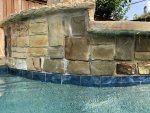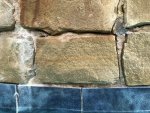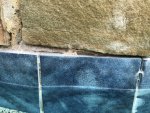Just to be up front, I got too aggressive with the acid earlier this summer. We have one main spot on the hot tub that seems to have scale - assumed to be calcium. It's almost like it just pours out of this one spot and runs down the side and leaves a white mess. We don't have a problem anywhere else in the pool, although the PH continues to go up and we add 8 to 12 oz of acid once to twice a week.
To say the least, to clean this, off acid worked well, it fizzled and bubbled and then washed away. The problem is I didn't dilute much in my spray bottle and it was a couple of weeks before I realized how well it was really working (and the damage I had done).
Do I need to take action or is there still enough mortar and grout in place around these stones and tile? The tile is still very secure, nothing loose. I know the tile was put on with a thin set or mastic and then the stone I guess just likely mortared in place. The pool is 5 years old.
First pic is a wide shot and then a few more close up around the stone and tile where. If anything is needed and if so what product is best to patch and will will it ever match or look like a big disaster if I do try a fix? I appreciate all of the advice, a lot of very knowledgable people here.
Also easy to see I need to so some more cleaning, however with a much more diluted solution of acid.


To say the least, to clean this, off acid worked well, it fizzled and bubbled and then washed away. The problem is I didn't dilute much in my spray bottle and it was a couple of weeks before I realized how well it was really working (and the damage I had done).
Do I need to take action or is there still enough mortar and grout in place around these stones and tile? The tile is still very secure, nothing loose. I know the tile was put on with a thin set or mastic and then the stone I guess just likely mortared in place. The pool is 5 years old.
First pic is a wide shot and then a few more close up around the stone and tile where. If anything is needed and if so what product is best to patch and will will it ever match or look like a big disaster if I do try a fix? I appreciate all of the advice, a lot of very knowledgable people here.
Also easy to see I need to so some more cleaning, however with a much more diluted solution of acid.




